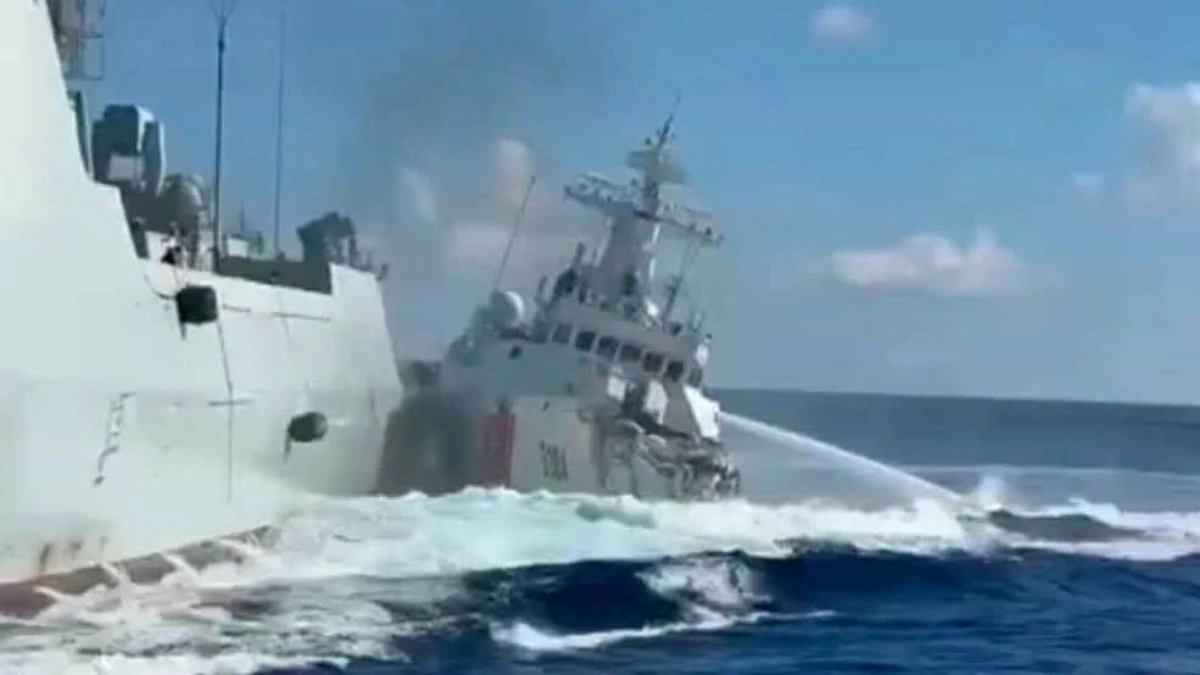In a dramatic escalation of maritime tensions, two Chinese vessels collided on Tuesday while pursuing a Philippine fisheries boat near the disputed Scarborough Shoal in the South China Sea. The incident, which unfolded in waters claimed by both Manila and Beijing, underscores the volatile nature of territorial disputes in one of the world’s most contested maritime regions. As regional powers and their allies watch closely, the event raises fresh concerns about the potential for broader conflict in an area critical to global trade and security.
Incident at Scarborough Shoal
The collision occurred early Tuesday morning when two Chinese ships, identified as coast guard or maritime militia vessels by Philippine authorities, attempted to intercept a Philippine fisheries boat near Scarborough Shoal, a reef located approximately 120 nautical miles west of Luzon. According to reports from Manila, the Chinese vessels were engaged in what appeared to be a coordinated maneuver to block the Philippine boat from accessing traditional fishing grounds. In the process, the two Chinese ships collided with each other, sustaining visible damage but no reported injuries.
Philippine officials described the incident as a stark illustration of aggressive tactics employed by Chinese forces in the region. The Philippine Coast Guard, which monitored the situation from a distance, noted that the fisheries boat managed to evade the Chinese vessels and return safely to shore. While no direct confrontation between Philippine and Chinese crews was reported during this specific encounter, the incident adds to a growing list of near-misses and hostile interactions in the South China Sea.
A History of Friction
Scarborough Shoal, known as Bajo de Masinloc in the Philippines and Huangyan Island in China, has been a flashpoint since 2012, when Beijing effectively seized control of the area following a tense standoff with Philippine forces. Despite a 2016 ruling by the Permanent Court of Arbitration in The Hague, which rejected China’s expansive claims over much of the South China Sea, Beijing has maintained a near-constant presence around the shoal, often deploying coast guard ships and fishing militias to assert dominance.
For Filipino fishermen, the shoal represents not just a source of livelihood but a symbol of national sovereignty. Many have reported being harassed or driven away by Chinese vessels, with accounts of water cannons, floating barriers, and even ramming attempts becoming alarmingly common. Tuesday’s collision, while not directly involving a Philippine vessel, serves as a reminder of the risks faced by those who venture into these contested waters.
Regional and International Reactions
The incident has drawn sharp responses from Philippine authorities, who have long accused China of provocative behavior in the South China Sea. While specific statements from officials on this particular event were not immediately available for verification, broader sentiments from Manila have consistently called for de-escalation and respect for international law. The Philippine government has repeatedly urged Beijing to adhere to the 2016 arbitral ruling, though China has dismissed the decision as non-binding.
Neighboring countries with overlapping claims in the South China Sea, including Vietnam and Malaysia, have also expressed concern over rising tensions in recent years. Hanoi and Kuala Lumpur, both of which have faced similar encounters with Chinese vessels, are likely to view this latest incident as part of a troubling pattern. Beyond Southeast Asia, the United States, a treaty ally of the Philippines, has reiterated its commitment to supporting Manila in defending its maritime rights, though no direct comment on Tuesday’s collision was verified at the time of writing.
Broader Implications for Stability
The South China Sea is a vital artery for global trade, with an estimated $3.4 trillion in annual commerce passing through its waters. It is also believed to hold significant reserves of oil and natural gas, adding an economic dimension to the geopolitical stakes. For China, control over the region aligns with its broader strategic ambitions, including the projection of naval power far beyond its shores. Beijing’s construction of artificial islands, complete with military installations, has only intensified concerns among rival claimants and their international partners.
For the Philippines, the challenge lies in balancing its economic ties with China against the need to protect its territorial integrity. Under President Ferdinand Marcos Jr., Manila has sought to strengthen defense cooperation with the United States and other allies, including Japan and Australia, while also pursuing diplomatic channels to manage disputes with Beijing. However, incidents like the one near Scarborough Shoal test the limits of diplomacy, raising the specter of unintended escalation.
The collision of Chinese vessels, while seemingly an accident, highlights the inherent dangers of militarized posturing in confined and contested spaces. Maritime experts note that the presence of multiple vessels, often operating under ambiguous chains of command, increases the likelihood of miscalculations. The South China Sea has seen similar incidents in the past, including collisions and near-collisions involving naval and civilian ships from various nations, each event chipping away at the fragile status quo.
Navigating a Path Forward
Efforts to manage tensions in the South China Sea have met with limited success. The Association of Southeast Asian Nations (ASEAN), of which the Philippines is a member, has been negotiating a Code of Conduct with China for over two decades, aiming to establish rules for behavior in disputed waters. Progress has been slow, hampered by disagreements over the code’s scope and enforceability. Meanwhile, joint military exercises between the Philippines and its allies, such as the annual Balikatan drills with the United States, signal a willingness to bolster deterrence, even as they risk further inflaming tensions.
For Filipino communities dependent on fishing in areas like Scarborough Shoal, the geopolitical chess game offers little immediate relief. Each encounter with Chinese vessels represents not just a threat to their safety but a disruption to their way of life. The resilience of these fishermen, who continue to navigate perilous waters in defense of their rights, mirrors the broader struggle of a nation caught between asserting sovereignty and avoiding conflict with a powerful neighbor.
Looking Ahead
As reports of Tuesday’s collision circulate, the incident serves as a microcosm of the larger challenges facing the South China Sea. With no clear mechanism for de-escalation and trust between claimants at a low ebb, the risk of a more serious confrontation looms large. Analysts suggest that confidence-building measures, such as joint fisheries agreements or shared resource management, could offer a pragmatic way forward, though political will for such initiatives remains uncertain.
For now, the waters around Scarborough Shoal remain a tinderbox, where a single misstep could ignite wider repercussions. As the Philippines and China navigate this latest flare-up, the international community watches with bated breath, aware that stability in the South China Sea is not just a regional concern but a global imperative. How both nations, along with their allies and neighbors, respond in the coming days may set the tone for maritime relations in one of the world’s most critical regions.
As tensions simmer, the question remains: can diplomacy prevail in a sea of competing claims, or are more collisions—literal and figurative—inevitable?















